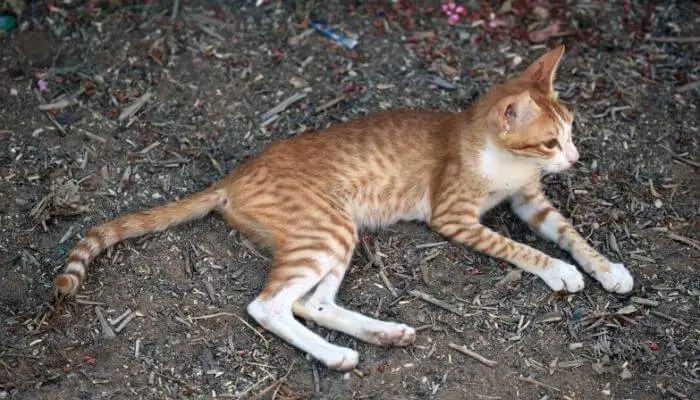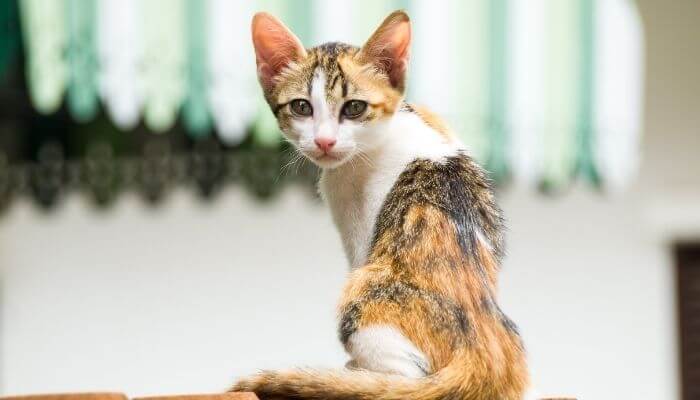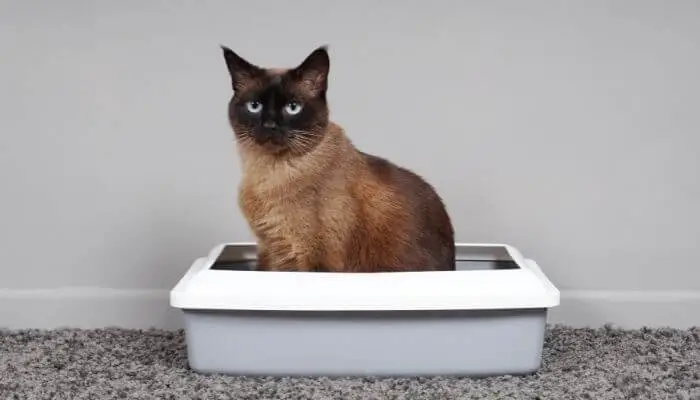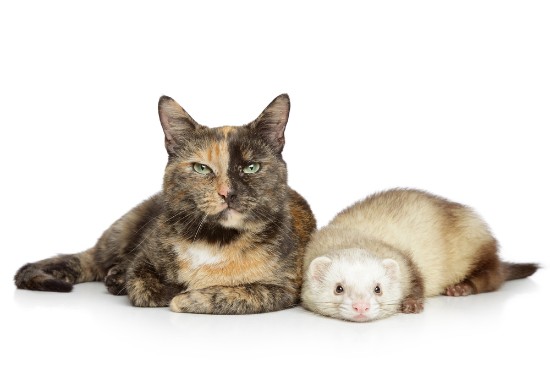A cat may be smaller or skinnier than average due to a health issue, internal parasites, their breed and genetics, or their age.
As there are so many factors that can impact a cat’s growth it is important to take your cat to the vet for diagnosis and treatment.
Below we’ve looked in more detail at the 9 main reasons a cat may be small or skinny.
Contents
Reasons Your Cat May Be Small and/or Skinny:
1. Nutritional Issues (Kitten)
Your cat may have been lacking some important nutrients when they were a kitten.
This could have been because the mother cat was unwell, was not producing enough milk for all the kittens or the mother may have passed away when the kittens still required milk.

Not getting enough nutrition in the early stages of life can result in stunted growth.
If your cat is still a kitten in the first five-six weeks of their life, they will still require milk feeds.
If they have started weaning they should be getting kitten wet food and milk.
Once weaned (this is usually at around eight-nine weeks old), the kitten should have access to kitten wet food at all times.
As they get a bit older, you can begin introducing dry food too.
2. Nutritional Issues (Adult)
Another nutrition-related reason could be that your cat isn’t getting enough food or enough nutrition from their current diet.
This may be because the food isn’t nutritionally balanced, isn’t suited to your cat’s age, or your cat isn’t eating the right amount of food each day.

Your cat needs to be fed high-quality food that is suitable for their life stage.
This can be dry, wet, or a mixture of both depending on your cat’s preferences.
Follow the instructions on the packaging of the food as this lets you know how much to feed and how often.
Adult cats tend to need feeding once or twice a day, or their daily dry food intake can be left out so they can come and go as they please.
Older cats (eight years old+) have different nutritional needs to adult cats so need food that is designed for their life stage.
You can also offer your cat treats (such as shop-bought treats or a small amount of cooked chicken or fish).
A great way to offer treats is by using food enrichment toys and puzzles to keep your cat interested and get them playing and thinking to access the treats.
If your cat has suddenly stopped eating, has not eaten for 2 days, is suddenly extremely hungry, is drinking a lot more than usual, or has lost weight for no apparent reason, take them to the vet as these are indications that something is wrong.
Cats that don’t eat can develop a liver condition that can be fatal.
3. It’s Not Fully Grown Yet
Your cat may be small because they are young and still growing.
If you’re not sure how old your cat is or you’re worried they aren’t growing as much as they should be, we recommend you get your cat checked by the vet.

The vet will be able to help you determine your cat’s age and will be able to offer you advice on monitoring their growth while ensuring they are receiving proper nutrition.
An easy way to check if your cat is still growing is to take weekly photos of them and compare the pictures.
4. Breed
There are some cat breeds that are smaller than others so your cat may be smaller because of their breed.

Your cat may also be a mixed breed with some ancestry links to smaller breeds and may have inherited genes from one of these breeds which have meant they are smaller in size.
Below we have listed some of the smaller cat breeds:
- Munchkin – this is one of the smallest cat breeds and remains small in size because of a gene mutation. Munchkin cats have shorter legs than other breeds and tend to have a kitten-like personality.
- Devon Rex – this small breed is known for having large ears, big eyes and a soft coat. Devon Rex cats have short whiskers and are similar to the Cornish Rex breed. However, the Cornish Rex breed tends to have longer whiskers.
- Singapura – Singapura cats are petite, they are around half the size of an average cat. They are active, affectionate, and are great climbers.
- Siamese – Siamese cats are skinny but athletic, they are one of the oldest breeds and adults weigh between 2.7 – 5.4kg.
- American Curl – this is a small cat that is known for having ears that curl backwards towards their skull. Due to the diverse gene pool of American Curl cats they come in a range of sizes but are usually petite.
The breed of your cat makes a big difference to their overall size and weight.
Some smaller breeds continue to look kitten-like even in their adult years.
5. Dwarfism
If your cat is small but also has short legs and a disproportionate body they may have dwarfism.
Dwarfism can be the result of hormonal deficiencies, growth plate abnormalities, genetic mutations, or chromosomal abnormalities.
Cats with dwarfism tend to have a shorter life span and may require ongoing medication.
Dwarfism is rare in cats but if your cat does have dwarfism they will probably need extra care due to potential health issues.
6. Worms
Your cat may be small/ skinny due to parasites such as worms. Internal parasites can cause weight loss and a range of symptoms such as diarrhea, bloat, coughing, and vomiting.

Worms are quite a common problem in cats and because the worms steal food and damage the lining of the gut they can cause weight loss as well as other problems.
Worming treatment should be given to adult cats every three months but cats that hunt a lot may require more regular treatment.
7. Feline Diabetes
If your cat is eating a lot but they are losing weight and seem to have excessive thirst and urination they may have feline diabetes.
This is a hormonal disorder which means their body is not producing enough insulin.
A vet will run tests to diagnose diabetes and then your cat will probably require a dietary change and insulin injections twice a day.
In some cases, diabetes can be controlled with diet alone.
8. Hyperthyroidism
Hyperthyroidism is when one or both thyroid glands are overactive.
The symptoms of hyperthyroidism are similar to diabetes, including increased appetite, weight loss, excessive thirst, excessive urination, and diarrhoea.

There is treatment available for hyperthyroidism so taking your cat to the vet for diagnosis and treatment is important.
9. Other Health Issues
There are many factors that can impact the growth of a cat.
The problem may be connected to your cat’s overall well-being (if they are sick often this can impact their growth and development even if the sickness itself is not related to their development).

If your cat’s growth issues are not connected to one of the listed causes, a vet may look at other health issues, hormonal factors, and environmental impact.
What Is A Normal Height/Weight For A Cat?
The average weight for most domestic cats is around 10 pounds (4.5kg), however, this varies depending on the breed as larger breeds will have a higher average which can be as much as 25 pounds (11kg) and smaller cat breeds can weigh as little as 5 pounds (2.2kg).
As you can see from our table below, the height and weight of a Singapura Cat (6” and 4 – 8 lbs) is much less than a Maine Coon (8 – 15” and 10 – 20 lbs).
| Cat Breed | Average Height | Average Weight |
|---|---|---|
| Tabby Cat | 9 inches (22cm) | 8 – 12 pounds (3.5 – 5.4kg) |
| Siamese | 8 – 10 inches (20 – 25cm) | 6 – 12 pounds (2.7 – 5.4kg) |
| Munchkin | 6 – 9 inches (15 – 22cm) | 4 – 9 pounds (1.8 – 4kg) |
| Singapura | 6 inches (15cm) | 4 – 8 pounds (1.8 – 3.6kg) |
| Maine Coon | 8 – 15 inches (20 – 38cm) | 10 – 20 pounds (4.5 – 9kg) |
| Bengal | 8 – 14 inches (20 – 35cm) | 6 – 15 pounds (2.7 – 6.8kg) |
| British Shorthair | 12 – 14 inches (30 – 35cm) | 7 – 17 pounds (3.2 – 7.7kg) |
| Ragdoll | 8 – 11 inches (20 – 28cm) | 10 – 20 pounds (4.5 – 9kg) |
How To Check If Your Cat Is Not Growing
During the first couple of months, a kitten grows very quickly.
From around 5 months old the kitten is starting to look like a small adult cat but will reach adulthood and more or less stop growing at around 1-year-old.
If you’re not sure if your cat is growing or is a healthy weight, it is a good idea to take them to the vet for a general health check.
You can also weigh your cat, visually check your cat’s form and take photos each week to monitor their size and weight.

This body condition tool can help you determine if your cat’s shape and size indicates they are underweight, ideal, or overweight too.
If you can see their ribs and backbone through their coat then they are underweight. If your cat has lost weight or is underweight it is important to find out why.
A vet can do a health check and perform blood tests to help find out the cause. They can also offer advice on how to get your cat to gain weight.
If your cat has never been able to gain weight they may have a health condition that is causing this, so a vet visit is still necessary.
What To Do If Your Cat Is Not Growing?
If you have been observing your cat, taking photos, weighing them etc. and you have found that your cat is not growing as they should, you need to find out why.
As we discussed above, there are several reasons a cat may not grow as they should so the best thing to do is take your cat to the vet.

A check-up at the vet will help you find out the cause of the slow or stunted growth, or at least help you rule out some of the possibilities.
- If the problem is parasites or infection, the vet will be able to prescribe medication and offer guidelines on an appropriate vaccination and deworming schedule for your cat.
- If the problem is due to your cat’s genetics, the vet will be able to run tests to diagnose the condition and will be able to give you more information about the condition and the needs of your cat.
- If the growth issue is caused by something else, the vet will be able to offer nutritional and practical advice to help you care for your cat.
In some cases, there are no treatment options so care recommendations will focus on managing symptoms and giving your cat the best quality of life.
Some growth issues can impact the life expectancy of the cat so this is worth discussing with the vet too.








Leave a Comment